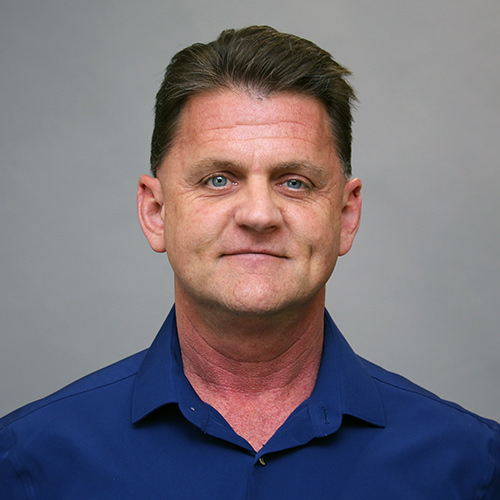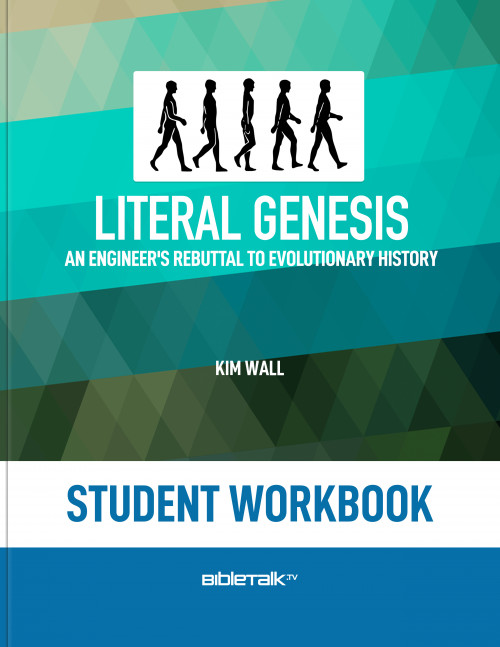Evolution's Extinction Engine
Part 2 – Single Cell
Welcome back to another session of Literal Genesis, where we strive to hold firmly to scripture and hold loosely to theories. As we've discovered many times over, the theories of man and flawed humans, they change all the time, it happens that way in science. So it's better to hold firmly to scripture. Anytime scripture touches on something like biology, which we're talking about now, that's what we want to hold firmly to, then we're likely to get our science right, if that's where we start from.
We're going to continue on with our conversation from last time where we had this analogy of how to build an airplane: how to take all these manuals, and not just build the airplane itself, but the tools; and not just the tools, but how to mine for the parts; and how to create the refineries to make the oil byproducts, and we ended up with all these manuals. And then we introduced evolution's engine, which I like to call evolution's extinction engine. When that's introduced, I compared it to a blind three-year-old with a marker, a pair of scissors and tape, just randomly making changes to our perfect instruction set. We talked about how over time, that's never going to lead to a better airplane or new functions that the airplane couldn't do before. Eventually it's going to take a perfectly fit airplane, and it's going to just degrade it to where it won't be able to fly at all. And depending on where those first changes are made, it may be very quick before the airplane is unable to fly.
Single Cell vs 747 Jumbo Jet
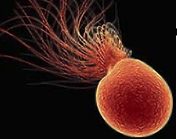
I want to switch gears just a little bit, and I say gears kind of loosely, because we're actually going to be talking about gears- no pun intended there. In order to do that, we're going to look at something in biology, in a bacterium, that's called the flagellum. If you take a look at the above image, this is a representation of a single-celled organism, it's a bacterium, that scientists have found in a fossilized form. Notice all the tail-like structures that come out from the end of it. They're not really called tails, they're called flagella, the plural of flagellum- when we're talking about biology. I'll probably still call them tails, because that's what they look like. These tails, they whip around and they propel, they cause the single-celled organism to move, they give it motion.
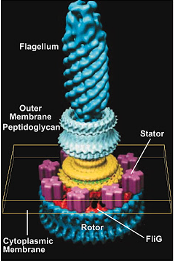
In order to drill in to how these things operate, if we look at this next image, we have a three-dimensional depiction of what's at the base of one of these tails. Notice the assembly. This is all proteins, right? So remember we talked about how, when the body needs a part or tool, it has to go manufacture it? These are some of the parts that it manufactures. We've given labels to these parts, but look at the nomenclature here. So again, this is like an outboard motor, if you will, on a boat. We have a rotor, so we call that a rotor because it rotates, it's the rotation part of this motor. And then we have a stator. It's the same terms we use when we talk about motors today. The stator is stationary, so it doesn't rotate, but these cogs turn and everything works together to make this thing turn.
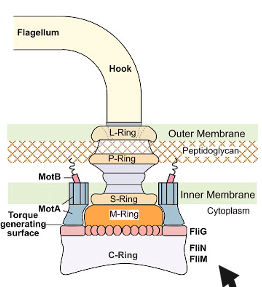
If we look above at the two-dimensional drawing of it, we can see how it's embedded in the membrane of the cell. So instead of an outboard motor, it's kind of like an inboard motor, where the motor itself is on the inside of the cell, and then the tail is on the outside. As you can imagine, all these parts must fit together perfectly, not loosely. They can't wear out after a few seconds, that would not be very efficient at all. But they work perfectly and there is a system in place to maintain it. As parts do wear out, they can be replaced, or the whole thing could be torn down and recycled. But if this didn't fit tightly inside the membrane, if it was kind of lose and wiggled around, that wouldn't work very well either. So this complete system is really amazing. And we use the same terminology, again, when we're talking about motors today, outboard motors.
"This so-called simple bacterium has nearly the same number of parts as that 747, about 6 million."
- Mark Rose
Pilot, Technician
This is absolutely mind-boggling. We talked about how complex a manual would have to be in order to make the 747 completely from scratch. It's no different in this single-celled bacterium. This is a single cell, right? We're multicell. This is just one cell, and it's highly complex and has around 6 million parts, which must fit together and work perfectly together, just like the airplane, or the airplane doesn't fly, or the bacterium doesn't survive.
But there's one thing that is simple- when I'm talking about biology and I use the word simple, just automatically know that it's in air quotes. There's nothing simple about it. But this simple cell can do something that the airplane cannot. It can reproduce itself, it can make copies of itself. It can make other single-celled organisms that operate independently and have its own set of DNA, with 6 million parts.
So anytime somebody tells you that these cells are simple, or they can spontaneously arise, which is another key word, by the way- whenever you hear the words they spontaneously arose in the literature, as Doctor James Tour likes to say, that's code for 'we have no idea.' Whenever something spontaneously arises, and you'll see this a lot in the literature, it really means they have no idea because there's never any details behind it. How something like this could spontaneously arise is beyond my scope of thinking.
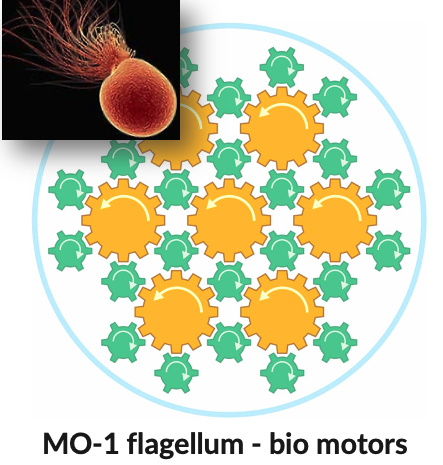
Let's take a closer look at this gear assembly that was found. This was found in the MO-1, this is the fossilized bacteria that I talked about. This is the MO-1, and we're looking at these flagellum. Notice the hexagonal array of these motors, these larger motors here, there's seven of them arranged in a hexagon. And if you look in between them, there's 24 smaller gears. What you're looking at is a planetary gearbox. This is something that mechanical engineers are very familiar with, they create them all the time. We find these all over the place, right? This takes human design to make this, but yet we're to believe that somehow, through a chance process, that nature built this blindly over some eons of time. That's absolutely incredible.
Now you'll notice that we call it a planetary gear system because we have the larger gears surrounded by smaller satellite gears, kind of like a planet, or sun and planet satellites. And if you look at the arrows, you can see the direction. The larger ones rotate counterclockwise and the smaller ones rotate clockwise. So it all has to fit together perfectly, and rotate perfectly, or it doesn't work, or the tail doesn't spin, the bacterium doesn't move, it can't get to where its food source is, and it'll eventually die.
This system must be in place in order for the single cell to live. These seven engines, they're more than just gears, these larger ones, these are actually engines because they're powered by protons. The seven proton-powered engines and all of it must work perfectly and fit together. To make this even more incredible, this bacterium was found in a rock that is supposedly 3 billion years old. Now let that sink in just for a second. Something this intricate was found in something supposedly 3 billion years old. That's not much younger than the Earth, right? Scientists say the Earth is around the same timeframe, 3.8 billion, let's just call it 4 billion years old.
So somehow this single cell appeared on the scene long before the Cambrian explosion, if you remember that from high school, that's the layer in the fossil record where we find all these different phylum, all together, fully formed from the beginning. This goes back before that. Something this intricate, supposedly- and I don't believe in those timeframes or those long ages, but if I did, this is absolutely something impossible to believe, that this flagellum has all these bio-motors, and they're there right from the beginning, with no path of evolution that we can see in the rocks.
Intelligence Behind Design
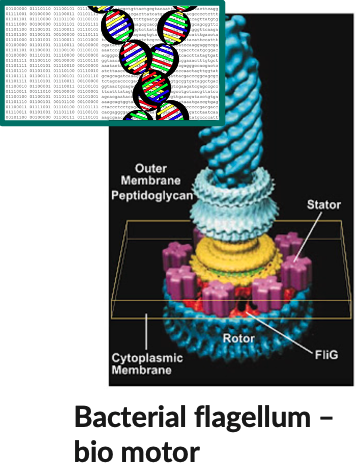
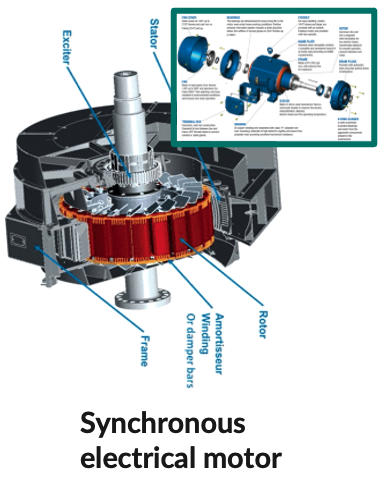
So let's take a closer look at this bacterial flagellum motor. And what I want to do is compare it to an electrical synchronous motor. The second image is flipped on its side so that they could both have the same orientation to make them match up a little bit. You'll notice they have the same types of words. They have rotors, they have stators. Now, I want to ask this critical question. I'm always saying we need to be critical thinkers, and what that means is, number one, we have to be curious, we need to ask questions, but ask the hard questions, ask the elephant in the room type questions, and that's regardless of the source. Whether it's coming from an evolutionary ideologist or coming from me, as you're reading scripture, be curious, ask questions, you will learn, you will grow from it. And the question that I want to ask here, looking at these two motors, is which motor can create itself? Can either one of these motors create itself? No one would say that the synchronous electrical motor could create itself.
When I ask this to people, I have yet to hear someone tell me, "Well, yeah, you put enough metal together in a room, you shake it together long enough, and you'll get a motor out of it." Nobody ever says that. But again, for some reason, because this one is built on biochemicals, bio parts, people say it can somehow assemble itself. That doesn't follow for me. Let's ask another critical question. We have a manual for this electrical synchronous motor. I've already been told by everybody I ask that there's no way the motor can create itself. Well, let me just take it a step further. Could this manual create itself so that you can have workers who can read the manual and produce more and more motors, as we need them? No one ever says that either.
We've already talked about that in the last session. Manuals do not create themselves. It doesn't matter how much time you give them, they have never been known to create themselves. Well, what about the manual for this motor? There is a manual for it. There's a manual for all these parts. There's a manual for the workers that know how to read the manual to create the parts, to assemble them at the right time in the right place. This is DNA, that's what DNA is.
Do you think that manual could write itself? Now, here's where we get a different answer. The answer is always,"Yeah, I could see that." Why is that? "Well, because it's chemical, it's chemistry-based, and chemicals have an attraction to one another." Okay, granted, but where does the code come from? Chemicals know nothing about the code in which they carry any more than the paper knows anything more about what I've written the paragraph on. It has no idea, it's just a medium. DNA is the medium.
Where did the code come from? Well, we'll look at that deeper. But this is a critical question, which I think I want more people to ask, I want more young people to ask. How did these things just write themselves over time? And if you think they do, show me. Show me how this happens. Cite a paper where they've done it in the lab and showed where it happens. It doesn't exist. You won't find it anywhere.
DNA is a Set of Manuals
Now, going back to David in the Psalms. Now that we've gone a little bit deeper, and we've seen how complex just our manual is to build a 747, and yet it's about the same amount of parts as that single-cell bacterium. We're made up of much more parts as humans. David says,
"I will give thanks to you because I am awesomely and wonderfully made. Wonderful are your works, and my soul knows it very well."
- Psalms 139:14
Again, I don't think David had a biology textbook. He didn't know anything about DNA, didn't know anything about the codes and the languages of the DNA. But all he had to do was look at how marvelous the human body is, with the amount of knowledge that he had, and immediately give credit to his creator. We should take note of that.
So in summary, DNA is a set of manuals, not just for us, but in that blade of grass outside, in that tree, in those insects, in the mammals, in the sea creatures. Everything, every living organism has DNA, and it uses the same code in everything. An evolutionist may say, well that's because everything evolved from the same thing, whereas someone who believes that codes don't create themselves would say, well, they just had a common designer. Whoever created the code, used the same code throughout the creation. I was a developer for a number of years. I wrote code, developed programs. This is very true. Once you have a good set of code, a good function that works, you're going to reuse that over and over again as a building block. It's the same thing we see in DNA.
So again, summarizing, it's an instruction set on how to build an entire human; and not just build humans, but how to maintain them, how to diagnose when things go wrong- we have self-diagnosing happening all the time within our bodies, how to correct things when they go wrong. It's not perfect. We have instructions on how to build the workers who know how to read the DNA so that they can carry out the instructions. It does you no good to have the DNA, a complete set of DNA, the instructions, if you have no workers in the cell that understand how to read it and how to build from it. Those two must exist at the same time.
And as we talked about, building the raw materials for our airplane- the manufacturing process, the refining process- this is done at a massive scale within our bodies. So we're made up of, and this number changes virtually every year, or every few years, but now the current thinking is that the average adult has about 70 trillion cells that makes up their body. About 40 trillion of that is bacterium. Believe it or not, we need help in living, and we have more bacterium than we do human cells. That's kind of crazy to think about, but we have about 30 trillion human cells. And inside of every one of those cells, with few exceptions, like red blood cells, we have this process of the manual: the reading of the manual, the creating of parts, the diagnosing of parts, the moving and shelving of parts, getting them to the right place at the right time. They're like miniature cities, and it's happening in every one of those cells.
Here's a Yale paleontologist. Now thinking about that three-year-old, that blind three-year-old messing with the manuals, making cuts, and making marks, and making changes. Elizabeth Vrba says,
"The idea that organisms are so complex that it is very hard to change one aspect without wrecking everything else."
- Elisabeth Vrba
Yale Paleontologist
And as we can imagine, in our example of the airplane manuals, that would seem very logically true, that making a change here is going to have a dramatic impact somewhere down the road, as long as that change happened not to be a neutral change, like we talked about, the color of the seats, for example.
Evolution = Change Over Time
So evolution is supposed to be change over time. That single-cell bacterium is never going to become anything other than a single-cell bacterium unless you change the manual. Now I never argue, well, I tend to make statements rather than make an argument, but evolution has changed over time.
Evolutionists say, well, don't you believe in change over time? And I say, well sure. You can't take any species alive on Earth today, and through observation over time, tell me that that species doesn't change in slight ways over time. Of course I believe that living things change in slight ways over time. What I don't believe is that one species changes into a completely different species, just like that airplane being randomly changed to somehow support flying back and forth into space. It takes too many changes, purposeful changes, not blind, random changes, to make something like that happen. So I do believe in change over time, but that change has to be upwards. Again, think of that single-cell bacteria, it's got to change upward into other living things. It can't have just minor changes, or near neutral changes, it's got to have major changes. The single cell doesn't know how to make an eye. Somehow it's got to get instructions on how to make an eye. It doesn't have a brain. Where do those instructions come from? It doesn't have a skeletal system, muscular system, circulatory system. It doesn't have any of these organs that humans have. Where do those instructions come from? Well, it has to get them from that blind three-year-old making changes to the manual.
That's the only place that it could come from. So change over time is observable, nobody denies that, but that's not the evolution that I'm talking about. We need to get our words clear. I'm talking about macro evolution, big changes over time, not these small changes we observe today, that we experience.
What we see is evolution's engine takes things in the wrong direction. Over time it takes them downward, and this has been documented time and time again. Nearly every disease known to man comes from a genetic mistake, a genetic change that's not desirable, a mutation that's in a place that's not good. This is what we observe, and I think the rest really is just fantasy. When you have no evidence or no observation to back it up, that's when we step out of the realm of science, and we step into the realm of fantasy.
If we go back to the scripture, go back to Genesis 1, it's recorded 10 times that living things reproduce after their own kind. Now, again, I'll say this over and over, I don't believe the Bible is a scientific textbook. I'm not going to go to med school armed with just the Bible in my hand, that'll never work. However, where scripture touches on science, and in this case where it touches on biology, we have to believe that the scripture is true.
And this is what we see, we back this up with our observation. Does any living thing ever reproduce something other than its own kind? And we'll talk more about those kinds when we get into the flood of Genesis 6, 7, and 8, but for now this is something experiential. Cattle produce cattle, horses produce horses, right? You have certain breeds that can intermix with each other, like dogs, for example, but they're all dogs. Nothing ever produces something other than its own kind.
God said it 10 times, we can take that, and we can launch our biology, we can launch our science based on that, knowing we're never going to get anything outside of living kind reproducing after its own kind.
Not only do we see that happening in real life, we see it in the fossil layers. I talked about, in a previous session, salamanders, supposedly 18 million years old, no difference to modern living salamanders. Things appear in the fossil record fully-formed as a species, and they exit just as quickly, fully-formed, without changing into anything else. This is observational, this is what we see. But there's another problem that we need to think about, if we're going to hold onto this idea of evolution, that somehow evolution did take place, and this blind three-year-old is responsible for it all, then we need to think about this: What if after every change that three-year-old made to this complex set of manuals, that someone came in the room right after she made the change and corrected it, put it back the way it was? Are we really ever going to get anything other than an airplane if this process happened every time? Well, you know what? This is exactly what happens in our DNA.
As these mistakes happen- we'll talk about that here in just a second, but as these mistakes happen, there are workers in the cell, there are enzymes that can detect these mistakes, and they come right along behind it and they repair those mistakes, for the most part.
How does this affect the DNA? How does this affect the evolutionary process? As that single cell, which they do have these error correction mechanisms, how are they ever going to get bigger and better, with new functions and new organs if, after every change, something comes along behind it, and repairs it, and corrects it, put it back the way it was? The evolutionary process can't even get off the ground.
The airplane will always be an airplane. The single cell will always be a single cell with this process. So let's take a look at these accidents, these mistakes that happen. When do they happen? Well, they happen most often during replication.
Yes, most of our cells, not all of them, do replicate. They divide, they separate, one cell becomes two, two becomes four, four becomes eight. You get the idea. Why do they do that? Well, let's look at an example. Say you skin your knee, something that happens a lot in my household, by me actually. So when this happens, when the knee is skinned, and there's a little laceration there, a little cut, the skin cells around that laceration communicate with one another, they say, it's time to kick into replication mode, and they replicate. They build more and more skin cells. And you want that around that area because you want it repaired. Now, this is in addition to the clotting factor, which is a whole other miracle of biology. But we do want our cells to replicate. And then as they replicate so many times, we don't want them to continue replicating forever, that's how cancer gets into our bodies- we have a cell that's got this runaway replication process. But normally cells know when to stop. They say, hey I've done my time, I've replicated X amount of times, it's time for me to go away, and the cell is recycled. But during this replication process, remember the DNA, the manual that's inside of these cells, if you're going to have two cells out of one, you need to have two copies of the manual because each of those cells needs to have its own copy of the manual. Well, the cell takes care of this perfectly. During the replication, at a specific point, it starts replicating the DNA, the instruction set, so that when that cell divides, you wind up with two cells each with its own copy. When those copies are made, this is when most of the mistakes are introduced. We call them mutations. Sometimes they're called point mutations. How often does this happen? Well, cell replication takes place about 2 trillion times every day in the average human, lots of replication going on.
Is there opportunity for lots of mistakes? You bet there is. How many? About one quintillion mistakes every day during this copy process. That's 10 to the 18th power. That's a one with 18 zeros after it. Think of it as a million billion. This is a lot of mistakes. Well, that doesn't seem to be right. If this many mistakes is accumulating or happening in our DNA, in our code, shouldn't we have all kinds of weird things as a result of it? We would, except the error process comes along, thankfully, and saves the day. It doesn't correct everything, but it gets it down to about 200 copy errors a day. Out of that quintillion errors that take place on average, the correction mechanism comes back and reduces that to a mere 200, a drop in the bucket compared to the amount of information we have in our manuals, just 200 a day, absolutely incredible.
Well, how long do you think we could survive, any living thing could survive, without this DNA error correction mechanism? Not very long at all. Remember, I said nearly every major disease known to man can be traced back to a mutation or a genetic problem, something not right, where we have an original set of instructions that have been changed somehow, and it's not a good change, and it leads to disease. We would have those diseases a lot earlier in life. We wouldn't live very long at all. I don't know what the estimation is, but I'd put the estimate, maybe, at a couple of years, at best. The human race would go extinct well within one generation if we didn't have this error correction mechanism.
Critical Thinking
So again, thinking about that instruction manual, if evolution is true, we have to change the manual. But when we have things coming right along behind those changes and fixing almost nearly all of them, that change will never happen. It's never going to go upward. And the changes we do see are neutral or lethal. Again, going back to critical thinking. Now this time, instead of asking a critical question of evolutionary ideology, let's take it back to scripture because in Genesis 1:31, God says,
"It is all very good."
- Genesis 1:31
His creation was good. Do you think that Adam and Eve were accumulating genetic errors as their cells divided every day? I don't think so. I don't think that could be a part of God's very good creation.
So if we put on our critical thinking hats, knowing what we know about what happened in Genesis 3 when Adam and Eve sinned, remember He gave these punishments, and it was a short list. It's certainly by no means meant to be everything that was going to change, but he told Adam, here's what's going to change for you: It's going to be harder. Working the ground, tending the garden, it's going to be harder. "By the sweat of your brow," He says. Eve had her own set of things that were going to be harder.
It could be that when sin was introduced in the world- God was sustaining it all anyway- couldn't He have just held back some of His sustaining power? And I think we get a glimpse of that in Colossians 1:17, it says,
"In Him, all things consist and hold together."
- Colossians 1:17
If He's holding it together to begin with, and He just lets back a little bit, that would introduce enough of the chaos that we see today.
This is one big problem, I think, for the atheists that I talk to. How can you believe in God when we look around and we see things like cancer, disease, things that affect children, all this bad, and how the design in our bodies is not optimal?
Well, according to scripture, it was optimal. It was very good. And when Adam introduced sin, things changed. And this is what we see today, the results of that sin, and things getting continually worse. I'm not saying the world's a bad place. I'm saying, genetically speaking, nothing is getting better. We're all winding down, so to speak. Geneticists will tell you that the human race is on a path to extinction with no way to reverse it. That matches what I read in scripture. When sin was introduced, some bad things happened. Going back to David, in Psalms 139:14,
"I will give thanks to You, for I am fearfully and wonderfully made. Wonderful are Your works, and my soul knows it very well."
- Psalms 139:14
And this time I want to look at that last sentence. Again, David didn't have a fraction of the knowledge of the human system and biology, at least presumably so. We have so much more knowledge, yet he knew that he was wonderfully made, and he gave credit to his Creator. How did he know? He says, "My soul knows it very well." When we go back to Genesis and we reread the account of the creation of Adam, in Genesis 2, God says He breathed the breath of life into Adam and he became a living soul.
There's something about humans that's different than the rest of creation. We have this piece of God that God gave to us, and when we die, when we pass from this life, that goes back to God, and He decides what to do with it from there.
When I say that this isn't a salvation issue, that you can believe in evolution if you want, remember the session we talked about the slippery slope that it causes in scripture, where you've got to compromise on so many passages of scripture that at some point, what are you left with? You're left with the book that you're saying, this can't all be true.
Now, that is a salvation issue, and can lead you to turn away from God. It's very important that, as Christians, we maintain a worldview that's based on scripture, because scripture never changes.
In our next session, we'll take this DNA example and we'll go just a little bit deeper into the amazing creation that God has made for us.


